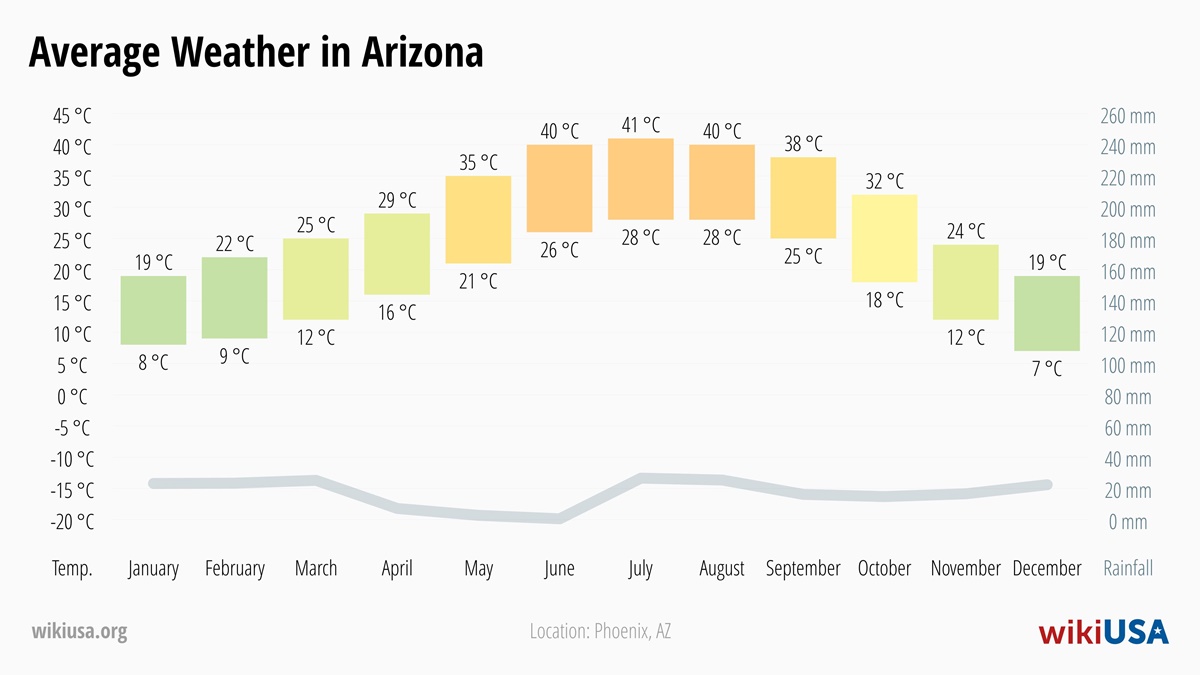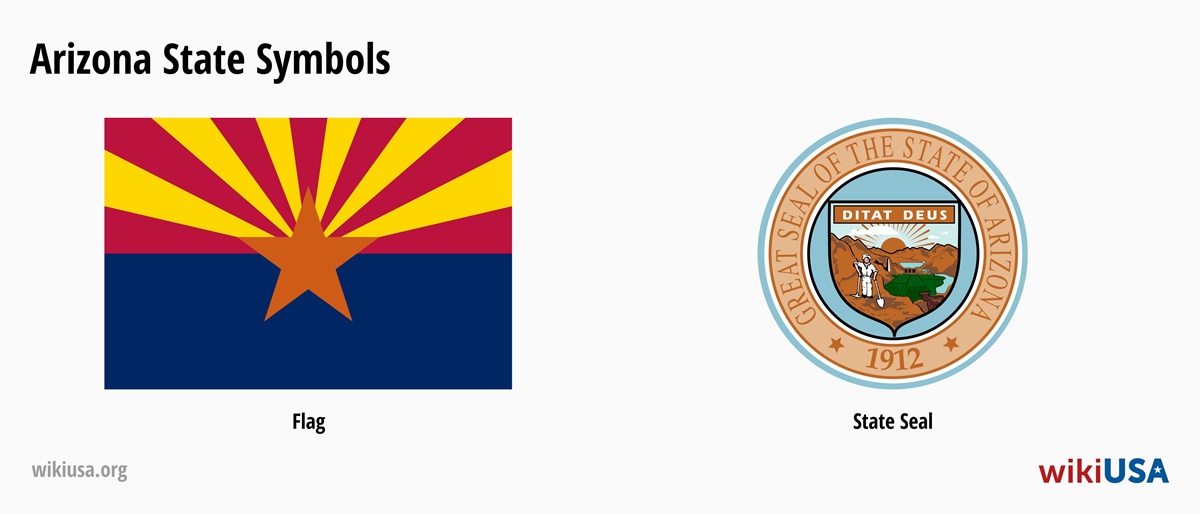Arizona (AZ) is located in the southwestern United States and is known for its hot desert climate and stunning natural scenery. It is home to national parks like the Grand Canyon, Saguaro, and the nature preserve Monument Valley. Arizona has more ghost towns than any other U.S. state, and tourism plays an important role in the local economy. The capital of Arizona is Phoenix. The state shares borders with California, Nevada, Utah, Colorado, and New Mexico.
-
Table of Contents
Basic Information
Name Arizona Abbreviation AZ Capital Phoenix Largest city Phoenix (Population: 1 650 070) Current time 1:54 Time zone MST (UTC-7), most of the state does not observe daylight saving time MDT (UTC-6) Population 7,157,902 (#14 most populous US state) Area 113,998 sqmi (#6 largest US state) Admitted to the Union February 14, 1912 (#48 state to join) ⭐ Capital of Arizona
The capital city of Arizona is Phoenix, founded in 1867 by American settler Jack Swilling. It was named after the mythical bird, the Phoenix, and became the state capital in 1889.
🏙️ Largest City in Arizona
The largest city in Arizona is the capital, Phoenix, with a population of 1,650,070 in 2023. The second-largest city is Tucson, with 547,239 residents, followed by Mesa with 511,648 residents.
🕒 Time in Arizona
The current time in Phoenix is 1:54. Arizona follows Mountain Standard Time (MST, UTC-7). The state is one of the few in the U.S. that does not observe daylight saving time, except for the Navajo Nation, which does.
🧑🤝🧑 Population of Arizona
In 2023, Arizona had a population of 7,157,902, making it the 14th most populous state in the U.S.
📍 Area of Arizona
The total area of Arizona is 113,998 sqmi, making it the 6th largest state in the U.S.
-
Fun Facts About Arizona
🧩 States That Border Arizona
Arizona shares borders with the U.S. states of California to the west, Nevada to the northwest, Utah to the north, and New Mexico to the east. It also shares a border with Mexico to the south and touches Colorado at the Four Corners point in the northeast.
📅 Date Arizona Joined the Union
Arizona joined the Union on February 14, 1912, as the 48th state, formed from the former Arizona Territory.
📛 Nicknames for the State of Arizona
Arizona has several nicknames, the most well-known being “The Grand Canyon State”, which refers to the popular tourist attraction and can be seen on license plates.
Another nickname, “The Copper State”, emerged in the early 20th century when Arizona produced more copper than any other U.S. state.
⛰️ Highest Mountain in Arizona
The highest mountain in Arizona is Humphreys Peak, located in the Coconino National Forest. Its summit reaches an elevation of 12,637 ft.
🏞️ Rivers in Arizona
The longest river in Arizona is the Colorado River, with a total length of 1,448 mi. It is followed by the Gila River (652 mi), the Little Colorado River (315 mi), the Salt River (199 mi), and the Santa Cruz River (184 mi).
🎓 Universities in Arizona
The largest university in Arizona is Arizona State University, with over 140,000 students. The second-largest is Grand Canyon University, founded on August 1, 1949, in Phoenix. The third-largest is the University of Phoenix, with approximately 90,000 students.
✉️ ZIP Codes in Arizona
Arizona has ZIP code ranges of 850xx–853xx, 855xx–857xx, 859xx–860xx, and 863xx–865xx. You can look up a ZIP code for any address on the USPS website, and find detailed information in the article ZIP Codes in the USA.
-
Weather in Arizona
The best times to visit Arizona are spring and fall, when temperatures are lower than in summer. Nature offers stunning scenery during these seasons. Temperatures vary across different parts of Arizona, mainly influenced by elevation.
Spring in Arizona is pleasantly warm, with temperatures ranging from 63 °F to 73 °F. Rainfall is minimal, creating favorable conditions for hiking and other outdoor activities. Cacti and other native plants are typically in full bloom.
Summer in Arizona is hot. In July and August, sudden downpours and strong thunderstorms may occur. Average temperatures range from 88 °F to 97 °F, with cooler conditions usually found in mountainous areas. In the lowlands, temperatures can climb to an extreme 104 °F to 113 °F.
Fall in Arizona brings a welcome drop in temperature. In the lowlands, temperatures typically range from 72 °F to 81 °F. The chance of rain and storms is lower, making it an ideal time to visit natural landmarks.
Winter in Arizona is mild, with temperatures usually ranging between 54 °F and 66 °F. Precipitation is minimal, making Arizona a popular escape from the colder weather experienced in other states.
🌡️ Average Temperatures and Rainfall in Arizona
-
What to See in Arizona
1️⃣ Grand Canyon National Park
One of the most popular attractions in Arizona is the Grand Canyon National Park, which spans an area of 1,901.96 sqmi. The South Rim is more frequently visited, offering hiking trails and viewpoints such as Mather Point and Yavapai Point.
The North Rim is less visited and therefore quieter. In addition to hiking down into the canyon, you can also take a helicopter tour for a breathtaking aerial view.
2️⃣ Monument Valley
The red sandstone formations of Monument Valley are among the most photographed locations in America, situated on the border between Arizona and Utah. You can admire the rock formations from your car by driving along Valley Drive. The entire area is part of the Navajo Nation’s tribal park.
3️⃣ Horseshoe Bend
Another iconic site in the American West is Horseshoe Bend, a large horseshoe-shaped meander of the Colorado River. Horseshoe Bend is located near the town of Page and is easily accessible via a short hiking trail. The best times to visit are early morning or late afternoon, when lighting conditions are ideal for photography.
4️⃣ Antelope Canyon
Near the river bend of Horseshoe Bend lies Antelope Canyon, another unmistakable destination in the American West. Entry into the narrow, orange- and pink-hued canyon walls is only permitted with a guide, but this should not deter you from visiting. The best time to see the famous light beams filtering into the canyon is midday during the summer months.
5️⃣ Saguaro National Park
Saguaro National Park is named after the iconic cacti that symbolize the American Southwest. These cacti can live up to 200 years, and you can get a closer look at them on one of the many hiking trails. Wildlife in the park includes coyotes, desert tortoises, and various bird species. The best time to visit the park is in the spring.
6️⃣ Petrified Forest National Park
Petrified Forest National Park features one of the largest and most colorful collections of petrified wood in the world. Visitors can explore walking trails that wind through trees that turned to stone more than 200 million years ago. For insights into how petrified wood forms and the park’s history, visit the on-site visitor centers.
7️⃣ Kartchner Caverns State Park
Kartchner Caverns State Park is home to a unique cave system discovered only in 1974 and now open to the public. Inside the caves, visitors can see well-preserved stalactites, stalagmites, and other limestone formations. Guided tours are required.
8️⃣ Meteor Crater
With a diameter of 0.7 mi, Meteor Crater is one of the best-preserved impact craters in the world. It is located 43 mi east of the city of Flagstaff. The crater was formed by a meteorite impact approximately 40,000 to 50,000 years ago. Visitors can learn more at the visitor center, which features observation decks. You can also walk along the crater’s rim.
9️⃣ Western Town of Tombstone
Step into the Wild West in the town of Tombstone, made famous by the gunfight at the O.K. Corral in 1881. The shootout site is fenced off, but you can view it up close with paid admission. For a few extra dollars, you can also attend a reenactment of the shootout.
🔟 Lake Powell
Lake Powell is a man-made reservoir on the Colorado River, created after the construction of Glen Canyon Dam. It is a popular retreat for fans of water sports, adrenaline activities, and fishing. The surrounding area offers plenty of campgrounds and hiking trails, and a visit can be easily combined with trips to Horseshoe Bend and Antelope Canyon.
-
Largest Cities in Arizona
The table shows the 10 largest cities in Arizona in 2023. The data source is the federal agency United States Census Bureau, whose main responsibility is conducting the national census.
City County Population 1 Phoenix Maricopa 1,650,070 Map of Phoenix 2 Tucson Pima 547,239 Map of Tucson 3 Mesa Maricopa 511,648 Map of Mesa 4 Chandler Maricopa 280,167 Map of Chandler 5 Gilbert Maricopa 275,411 Map of Gilbert 6 Glendale Maricopa 253,855 Map of Glendale 7 Scottsdale Maricopa 244,394 Map of Scottsdale 8 Peoria Maricopa, Yavapai 198,750 Map of Peoria 9 Tempe Maricopa 189,834 Map of Tempe 10 Surprise Maricopa 158,285 Map of Surprise -
Sports Teams in Arizona
🏒 Hockey (NHL)
There is no NHL team currently based in Arizona. Until the 2024 season, the Arizona Coyotes from the Phoenix metropolitan area played in the league.
🏈 American Football (NFL)
The Arizona Cardinals are one of the founding teams of the National Football League (NFL), having played their first season in 1920. The Cardinals are part of the NFC West Division and their team colors are cardinal red, white, black, and silver. The team plays its home games at State Farm Stadium in Glendale.
🏀 Basketball (NBA)
The only NBA team from Arizona since the 1968 season has been the Phoenix Suns, part of the Pacific Division in the Western Conference. The team colors are purple, orange, black, gray, and yellow. They play their home games at the Footprint Center in Phoenix.
⚾ Baseball (MLB)
The Arizona Diamondbacks have been part of the National League’s West Division since the 1998 season. They play their home games at Chase Field in Phoenix, and their team colors are red, teal, black, and white.
⚽ Soccer (MLS)
No team from Arizona currently plays in Major League Soccer (MLS).
-
State Symbols of Arizona
Arizona has a wide range of official symbols, with some of the most notable listed below.
Flag of the State of Arizona
Arizona’s state flag was adopted in its current form in 1917. Its design features 13 red and gold rays, representing both Arizona’s sunsets and the original 13 American colonies. The uniquely colored star symbolizes the importance of copper mining.
Seal of the State of Arizona
The Great Seal of the State of Arizona was officially adopted in 1911, one year before Arizona joined the Union. Its design includes the Latin motto “Ditat Deus”, which translates to “God Enriches”.
State Flower
Since 1931, the official state flower of Arizona has been the saguaro cactus (Carnegiea gigantea), found in the Sonoran Desert.
State Tree
In 1954, the broadleaf Parkinsonia florida was designated as the state tree. It can be found in the Sonoran Desert.
State Reptile
Arizona’s official state reptile since 1986 has been the Arizona ridge-nosed rattlesnake (Crotalus willardi). The species is named after its discoverer, Frank Cottle Willard, a merchant from the town of Tombstone.
State Metal
Copper has been one of Arizona’s official symbols since 2015 and has been mined in the state since the late 19th century.
State Mineral
In 2017, orange-red wulfenite was declared Arizona’s official state mineral.
State Dinosaur
Since 2018, one of Arizona’s state symbols has been the Sonorasaurus, whose fossils were discovered in the Sonoran Desert of Arizona.
State Fossil
Arizona’s state fossil since 1988 has been petrified wood, most famously found in Petrified Forest National Park.
State Amphibian
Arizona’s official state amphibian since 1986 has been the mountain tree frog (Hyla eximia), also known as the Arizona tree frog.

 10 Best Photo Places in the USA
10 Best Photo Places in the USA







Contribute with Your Question or Personal Experience